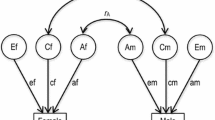Abstract
In order to assess the validity of school history information as a diagnostic criterion for reading disability, reading performance data from 304 children with a positive history for reading problems were compared to those from 319 children with a negative school history. These children are members of twin pairs who are participants in the Colorado Reading Project (DeFries 1985). A multivariate analysis of variance of Reading Recognition, Reading Comprehension, and Spelling subtest scores from the Peabody Individual Achievement Test (Dunn and Markwardt 1970) yielded a highly significant (p <0.001) difference between groups for both the multivariate and univariate comparisons. The difference between the unweighted mean scores of the school-history positive and negative groups for Reading Recognition was 2.1 standard deviations. Moreover, when discriminant weights estimated from an independent sample of 140 reading-disabled and 140 control nontwin children were used to reclassify the sample of twins, 75% of those with a positive history for reading problems were classified as being reading disabled and 95% of those with a negative history were classified as unaffected. Thus, results of this study establish the validity of school history information and suggest that such information may have considerable utility for ascertaining samples of reading-disabled children.
Similar content being viewed by others
References
Carter H. L. and McGinnis D. J. 1970. Diagnosis and treatment of the disabled reader. Toronto: The Macmillan Company.
DeFries J. C. 1985. Colorado reading project. In D. B. Gray and J. F. Kavanagh (eds), Biobehavioral measures of dyslexia (pp. 107–122). Parkton, MD: York Press.
DeFries J. C. and Baker L. A. 1983. Colorado Family Reading Study: Longitudinal analyses. Annals of Dyslexia, 33, 153–162.
DeFries J. C., Volger G. P. and LaBuda M. C. 1986. Colorado Family Reading Study: An overview. In J. L. Fuller and E. C. Simmel (eds), Perspectives in behavior genetics (pp. 29–56). Hillsdale, NJ: Lawrence Erlbaum Associates.
Dunn L. M. and Markwardt F. C. 1970. Examiner's manual: Peabody Individual Achievement Test. Circle Pines, MN: American Guidance Service.
Finucci J. M. and Childs B. 1981. Are there really more dyslexic boys than girls? In A. Ansara, N. Geschwind, A. Galaburda, M. Albert and N. Gartrell (eds), Sex differences in dyslexia (pp. 11–19). Towson, MD: Orton Dyslexia Society.
Lykken D. T., Tellegen A. and DeRubeis R. 1978. Volunteer bias in twin research: The rule of two-thirds. Social Biology, 25, 1–9.
Nichols R. C. and Bilbro W. C. 1966. The diagnosis of twin zygosity. Acta Genetica, 16, 265–275.
Richek M. A., List L. K. and Lerner J. W. 1983. Reading problems: Diagnosis and remediation. Englewood Cliffs, NJ: Prentice-Hall, Inc.
SPSS-X 1988. Statistical Package for the Social Sciences (3rd ed.) [Computer program]. Chicago: SPSS Inc.
Wechsler D. I. 1974. Examiner's manual: Wechsler Intelligence Scale for Children—Revised. New York: Psychological Corporation.
Wechsler D. I. 1981. Examiner's manual: Wechsler Adult Intelligence Scale — Revised. New York: Psychological Corporation.
Author information
Authors and Affiliations
Rights and permissions
About this article
Cite this article
Gillis, J.J., Defries, J.C. Validity of school history as a diagnostic criterion for reading disability. Read Writ 1, 93–101 (1989). https://doi.org/10.1007/BF00377464
Issue Date:
DOI: https://doi.org/10.1007/BF00377464




